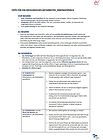Tips for a successful appraisal interview
BEFORE YOU BEGIN
- Define goals, interests and priorities for the interview in advance. Are there any specifications, guidelines, framework conditions that need to be taken into account
- Choose a suitable location for the appraisal interview. Possibly meet on “neutral ground” in order to be able to conduct the meeting as equals.
- Think about a good opening for the meeting.
AT THE BEGINNING
- Even before the interview begins, attention should be paid to creating a positive mood on the part of both the manager and the employee. The manager should also take particular care to create a safe and trusting environment for the MAG to take place.
- Both parties should prevent potential disruptive factors (switch off phones, put a “do not disturb” note on the office door, etc.) so that the meeting can be conducted with full attention for each other.
IN CONVERSATION
- The 70/30 rule: A MAG must not be a monologue by the manager. On the contrary. The employee should be allowed to speak up to 70% of the time. After all, one aim of the appraisal meeting should be for the employee to open up to the manager.
- The manager can encourage the dialog by signaling their openness, e.g. by adopting an attentive posture, asking open questions, listening patiently, summarizing what has been said with possible follow-up questions and subsequent reference and comments.
- Examples of open questions:
|
Concerning the employee's tasks/area of work |
|
|
Concerning the employee's well-being and work-life balance
|
|
|
Concerning leadership and organizational culture |
|
|
Regarding the employee's future and development prospects |
|
- The perception and appreciation of the employee's performance by the manager plays an important role in the MAG.
- Feedback can be both positive feedback and an opportunity to articulate and concretize suggestions for improvement. When giving feedback, it is important to use respectful wording. It is therefore advisable to formulate observations and personal perceptions in “I” form. The more concrete and clear the statements are, the more useful they can be for the further course of the conversation and future work performance.
“I” messages with the WWW formula:
|
Perception: Description without evaluation
|
Effect: expressing feelings and needs |
Request: Proposal for future interaction |
|
IMPORTANT: Stay on the level of observation and description, DO NOT explain and evaluate. |
IMPORTANT: Negative feelings arise because your needs are not being met! |
IMPORTANT: A request is not a demand! You cannot force anyone to fulfill your needs, even if you often think you can. |
|
I perceive ..... |
That causes me ... |
For the future, I would like ... I would be very happy if we could come to an agreement regarding ....
|
AFTER THE MEETING
Follow-up involves both parties adhering to the agreements made during the performance review. The manager should check this at the next appraisal meeting at the latest.
Compiled by:
Human Resources Development - Center for Continuing Education, mdw - University of Music and Performing Arts Vienna
Sources:
Eudaimonic.at - Well-being and potential development at work and in everyday life, https://www.eudaimonic.at/blog/ich-botschaften/ (last accessed January 30, 2022)
Karriereblog.at - Hello coach! Good leadership shows itself in the performance review, https://www.karriere.at/blog/mitarbeitergespraech-fragen.html (last accessed January 30, 2022)
Suggestions. Reflections on conducting conversations - types of conversations, Gudrun Weinberger, JABIL, “Successfully conducting difficult staff appraisals”, seminar 2011
Non-violent communication: A language of life, Marshall B. Rosenberg, revised and expanded new edition, Junfermann Verlag, 2016
